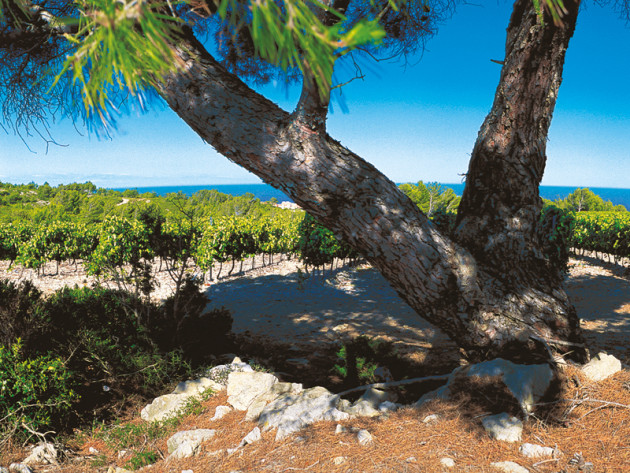
Harnessing Pays d’Oc IGP
Inviting a panel to taste and talk, Andrew Catchpole prompted a far-reaching exploration of the potential for southern France’s most versatile designation, in partnership with Pays d’Oc IGP.
The panel: Hamish Chambers, manager, The Vineking; Andy Leathley, account executive, Sommelier’s Choice; Jason Millar, director, Theatre of Wine; and Emily Silva, head of retail & marketing, Oxford Wine Company.

With 58 varieties to play, spread across innumerable terroirs and soils through the Languedoc-Roussillon, the Pays d’Oc IGP wines offer a vibrant mix of punchy character, good value and an increasing focus on sustainability. It’s an inviting package, providing a highly fertile hunting ground for individual finds and attractive additions to portfolios.
Our panel generally agreed, having first tasted through a selection of 56 wines – including the more off-piste likes of Albariño and Rolle, Carignan and Nielluccio – as a backdrop to the discussion.
“There’s a real opportunity [for producers] with Pays d’Oc to really express themselves with the grapes, and we saw quite a lot of differing vinification techniques, so the personality really comes through, which is more difficult in, say, Bordeaux or Burgundy, because everyone is using the same grapes as everyone else,” said Andy Leathley.
This was a plus, Jason Millar agreed, allowing buyers ample opportunity to “cherrypick” the best examples from a given producer’s portfolio, whether that be (for example) Viognier, Albariño, Chardonnay, Sauvignon Blanc, or any mix of what stands out. “It’s an interesting region because it’s really France’s answer to the New World – you have a lot more freedom to do what you want, to experiment,” added Millar. “We’ve tasted Marselan and Malbec, and it’s an opportunity for creativity, for winemakers to do interesting things.”
The panel agreed that the clearest way to navigate the Pays d’Oc IGP – which rigorously rejects wines that don’t meet the quality standards and traceability – remains via either the producer or variety, with familiarity of the former being the most useful reference.
“I think the customer still tends to lump the whole region together, having a very vague knowledge of southern France, and the geographical relationship different regions have with each other,” said Hamish Chambers.
“So when you get a decent winemaker who knows what they are doing, with the ability to express and show that individuality, it’s going to work and going to be commercial, while being characterful.”
Emily Silva added that the freedoms allowed in winemaking appear to be translating through to innovative and eye-catching label design too, with “some really strong branding... doing a good job of standing out”.
All of this adds up to an attractive overall package, in the words of Millar, leaving the Pays d’Oc more than able to “compete directly with the New World”, from entry level upwards.
Chambers concurred, adding: “I find it quite a useful region in that if you have a customer who is very New World driven, you can bring them back to the Old World, to France, because [Pays d’Oc IGP] has that kind of approachability that appeals.”
From fresh rosés to rich Syrahs by way off all between, the panel agreed that with prices from Provence to the Rhône (and similarly competing styles around the globe) inching ever upwards, the Pays d’Oc IGP offers some very attractive price-to- quality ratios for the buyer.
“This is where the Pays d’Oc can really step in. There’s an opportunity to look at gaps in the market, because there’s loads of value to be had in many of these wines and they can compete well with areas that are increasingly expensive,” added Millar.
Silva also highlighted how importing direct from southern France “is easier than from the New World”, summing up another factor in favour of sourcing wines from Pays d’Oc IGP.
Tasting high points
The 56 wines tasted showed well across the flights, suggesting a bar set high when it comes to Pays d’Oc IGP quality, but some really stood out for our panel. (NB: Price either retail from the domaine or UK rrp).
Whites
1. Les Vignobles Foncalieu, Sillages, Albariño 2020 (RRP £13, Importer: Le Bon Vin)
“Citrus and peach hints, fresh minerality”

2. Aubert & Mathieu, Kate, Sauvignon Blanc 2020 (RRP £12, Importer: Enotria)
“Lovely, lively, grassy fresh, good texture”

3. Domaine des Homs, Viognier 2020 (€14, seeking importer)
“Poised, balanced, complex style”

4. Domaine La Provenquière, Marsanne 2020 (RRP £11, Importer: Hallgarten & Novum Wines)
“Honeysuckle and nutty notes, creamy palate, good length”

5. Domaines Bonfils/Domaine de Cibadiès Pegasus, Chardonnay 2020 (€8, seeking importer)
“Rounded, complex, youthful, mineral-lined”

Rosés
1. Les Vignobles Plaza Tedaldi, Domaine Borie Neuve, Coq aux Vents, Cinsault Rosé 2020 (€9, seeking importer)
“Delicate hue, crisp, poised, fresh style”

2. Vignobles & Compagnie, Le Petit Cochonnet, Grenache Rosé 2021 (RRP £5.99, Importer : Albion Wine)
“Enticing soft red fruits and food-friendly structure”

Reds
1. Aubert & Mathieu, Amy, Grenache/ Syrah 2020 (RRP £12, Importer: Enotria)
“Good intensity and depth, well rounded”

2. Abbotts & Delaunay, Métayage Pinot Noir 2020 (€13, seeking importer)
“Attractive Pinot character, some savoury depth”

3. Domaine Les Yeuses, La Petite Syrah 2020 (RRP £8.95, Importer: Lea and Sandeman)
“Bright, juicy, attractive style”

4. Domaine Sibille, Syrah 2020 (€9.50, seeking importer)
“Rich, spicy, aromatic wine with good length”

5. Domaine Rose et Paul, Merlot 2019 (€7, seeking importer)
“Rich, rounded style, spice and cedar on finish”

6. Domaine de l’Herbe Sainte, Harmonie Malbec 2020 (€8, seeking importer)
“Well-balanced, fresh, attractive wine”

Harpers would like to thank the team at the Wine & Spirit Education Trust for hosting our tasting and discussion at its Bermondsey HQ.
Keywords:
- wine
- Round table
- indies
- oxford wine company
- tasting
- The Vineking
- Languedoc-Roussillon
- southern france
- Theatre of Wine
- Emily Silva
- Pays d’Oc IGP
- independents merchants
- Hamish Chambers
- Andy Leathley
- Sommelier’s Choice
- Jason Millar




